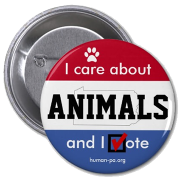Update: SB 644 was amended, and although it is a small step in the right direction, this ill-conceived bill which threatens Pennsylvania’s native habitat and allows cruel canned hunts has passed and was signed into law. At a time when states across the country are halting the importation of wild boars, Pennsylvania took a leap backwards. Humane PA will include this vote on its scorecard, because although attempts have been made to improve the language, this bill is dangerous to animals and the environment. 
The Pennsylvania Game Commission (PGC) was in the process of considering a proposed rule that would have prohibited the possession, importation and release into the wild of feral pigs. This rule would also have given the PGC authority to regulate feral pigs in captive or “canned” hunts – fenced pens where trophy-seekers can pay to shoot the trapped animals for guaranteed kills. The Commission unanimously voted in favor of the proposed rule at its January and April meetings.
SB 644 was a dangerous and short sighted bill that eliminated the PGC’s authority over captive feral pigs – preventing the PGC from implementing its sound, proposed rule to regulate feral pig captive hunt operations throughout the state, and moved it under the Department of Agriculture.
The problem with captive hunts:
Animals in captive hunts are stocked inside fenced enclosures, allowing ranches to often offer guaranteed trophies, “100 percent success” rates, and advertise “no kill, no pay” policies. Captive hunts are generally reviled by the hunting community nationwide for violating the principle of fair chase. Hunting groups such as the Boone and Crockett Club and the Pope and Young Club, which maintain trophy records for big game hunting, will not consider animals shot at captive hunts for inclusion on their record lists.
The problem with feral pig captive hunting operations
Pennsylvania and a majority of surrounding states are currently facing increasing problems from escaped feral pigs colonizing, reproducing rapidly, and threatening native wildlife, habitat and agriculture. If conditions are right, feral pigs can breed at six months of age and have three litters a year averaging four-six piglets each litter. Feral pigs’ foraging, rooting and wallowing behavior can cause significant damage to agricultural crops, trees and other plants, as well as erosion of river and stream banks and destruction of wetlands. In fact, the USDA estimates that feral pigs inflict more than one billion dollars in damages every year. Further, feral pigs and wild boar carry transferable diseases, such as pseudorabies and brucellosis, which threaten domestic livestock populations.
There is substantial evidence that free-roaming feral pig populations are often the result of escape or release of animals from private hunting preserves. A USDA study conducted for New York’s Invasive Species Council in 2012 found that “shooting preserves, both in and out-of-state, can be a source of feral swine damage to New York.” One large captive hunting facility on the border of Pennsylvania and New York – the “Tioga Boar Hunting Preserve” – imports wild boar and allows the hunting of these animals for a fee. The Tioga Preserve, which is the subject of litigation over the Game Commission’s failure to enforce the state Game and Wildlife Code, has previously imported dozens of wild boar into Pennsylvania each month (41 in January 2009, 32 in February 2009), making it a potentially significant source of further escape, release and proliferation of free-roaming wild boar in the state.
Please contact your Representative to oppose SB 644.
Recent articles:
AgWeek: A whole-hog effort to destroy wild pigs
Philadelphia Inquirer: Pa. bill would stop game panel from banning wild boars
New York Times: When One Man’s Game Is Also a Marauding Pest

